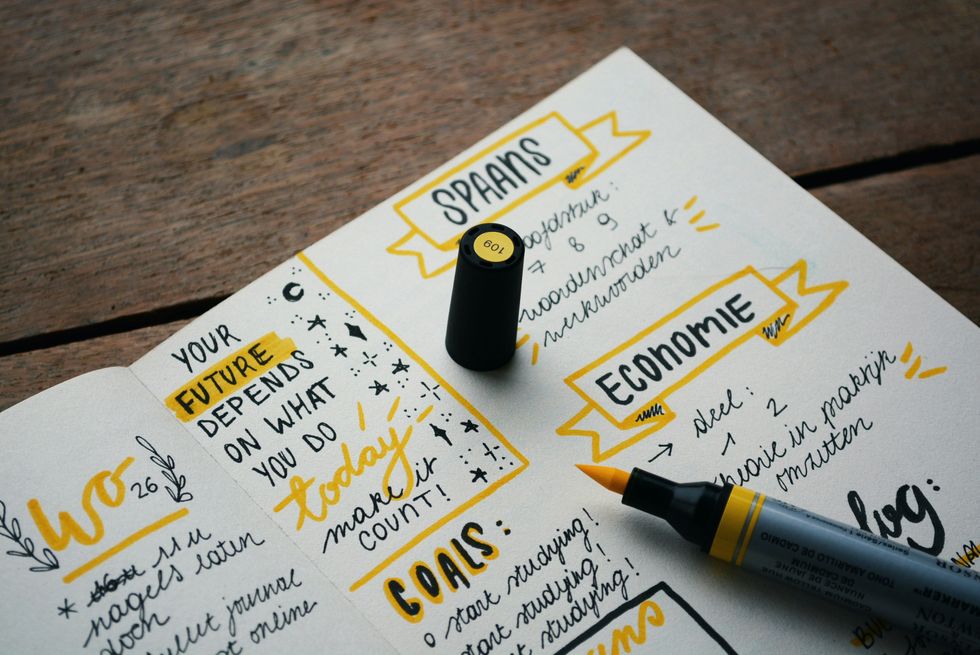1. Don’t buy Textbooks the first week of class.
Trust me. You are either going to drop or swap a class because you won't like all of them. Trust me, it's okay to switch!
2. Ratemyprofessor.com! PLEASE use it!
 "I thought you knew what you signed up for."
"I thought you knew what you signed up for."
This happens every semester, even when you were the one who picked them!God bless all of the students who actively write reviews on this website, because it helps with picking classes and professors. Be aware that not all of the reviews are agreeable. However, this has helped me 90% of the time when picking classes for the next semester.
3. Don’t wear your lanyard or ID around your neck, it makes it obvious for everyone to know you’re a freshman.
When Jamie Lynn Spears did it on Zoey 101, everyone thought it was cool! But it also signifies that you are a freshman. There’s nothing wrong with it! But do you really want people targeting you and knowing that you’re a freshman?
4. Always bring a charger or headphones wherever you go.
You may think your phone isn’t going to die, but trust me, there’s always a chance you’ll be bored out of your mind during lectures and will want to surf the web during the whole class. Always be prepared for a back up! Also, it would suck if you were almost done with your paper and your laptop dies. And for headphones…I mean this is obvious!
5. Don’t miss out on the free food on campus.
Would you rather spend a meal and regret it? Or just binge on free food and save some meals for the week?
6. You don’t always need to dress up…Trust Me!
Seriously, no one cares about what you’re wearing. It’s okay to wear the same hoodie and sweats 3 days in a row. You’re on a college campus and wearing heels? Good luck walking!
7. Get More Involved!
Join clubs or a sorority/frat! Either way, get involved and make new friends! This will make your college experience 10x better!
8. Don’t feel pressured to hook-up with anyone.
 man and woman in bathtub
Photo by We-Vibe Toys on Unsplash
man and woman in bathtub
Photo by We-Vibe Toys on Unsplash
Seriously, that is not what college is about. Don’t believe what you see in college movies. Hooking up doesn’t get you brownie points or help with your career! It’s nice to experience college culture, but don’t over-do it! And remember it’s always okay to say NO!
9. The Freshman 15 is REAL! Don’t brush it off!
Don’t be fooled by the amount of hills and space on campus. The food will fill you up fast and a lot of dining halls are all-you-can-eat!
10. It’s OK to say NO!
You don’t always have to go eat with someone or go to the club. Sometimes, you need some “you” time!
11. Drinking / Partying doesn’t equal popularity.
You don’t need to fit in! There’s no such thing as “fitting in” in college. Remember, you’re not in high school anymore.
12. Try to spend less time in your dorm.
 four women sitting on black steel bench during daytime
Photo by Chris Murray on Unsplash
four women sitting on black steel bench during daytime
Photo by Chris Murray on Unsplash
Like I said earlier, go out, get involved, and meet new people!
13. It’s OK to change your major!
The purpose of college is exploring! Try new classes. You might like some and eventually, pick a major for you.
14. Always take an Uber or Lyft!
 Uber app ready to ride on a smartphone.
Photo by Tingey Injury Law Firm on Unsplash
Uber app ready to ride on a smartphone.
Photo by Tingey Injury Law Firm on Unsplash
These services will be one of your best friends! They are always there whenever you need them, and they are safe.
15. Never go to a party alone!
 woman in red tank top and blue denim shorts standing beside woman in black tank top
Photo by LOGAN WEAVER | @LGNWVR on Unsplash
woman in red tank top and blue denim shorts standing beside woman in black tank top
Photo by LOGAN WEAVER | @LGNWVR on Unsplash
I can’t stress this enough! Especially if you are in an area you are unfamiliar with, do not go alone and NEVER go home with a random stranger without your friends.
16. Start your resume early.
 blue marker on white printer paper
Photo by Estée Janssens on Unsplash
blue marker on white printer paper
Photo by Estée Janssens on Unsplash
Go to your school’s career center to start building your references! I mean you have to focus on your future! Why are you in college?
17. Keep your door open when in your room.
 welcome signage on focus photography
Photo by Aaron Burden on Unsplash
welcome signage on focus photography
Photo by Aaron Burden on Unsplash
This is a great way to make some new friends. That means clean your room too to make it presentable.
18. Get to know your professors.
If they have office hours, take advantage of those times. It’s not like you can answer a question in class and the teacher will automatically remember you. Keep in mind that your professor teaches 300 other students. Try to make an effort to get to know them during their office hours for some one-on-one extra help!
19. You don’t really need an unlimited meal plan.
This is an easy access to the ‘Freshman 15,’ and you might as well save some money by cooking anyway!
20. Procrastinate = LATE!
Don’t push away your 12-page paper, 7-page essay, and 2 online quizzes. It will bite you in the end when the deadline hits.
21. If you need to…sleep!
 woman in white and black striped long sleeve shirt lying on bed
Photo by MILAN GAZIEV on Unsplash
woman in white and black striped long sleeve shirt lying on bed
Photo by MILAN GAZIEV on Unsplash
Your bed can also be your best friend! It’s like your sacred spot. Taking power naps or binge-watching Netflix occurs here. But always be active too!
22. It’s also OK to say ‘no’ to going out all the time!
Grades always come first, or sometimes, you may be tired. Every once in a while, it's important to have some me-time! Don’t fall into peer pressure. It’s okay to have FOMO, or seeing your friend’s Snapchat stories. It’s not like it’s the only party…….that week!
23. Take advantage of the free stuff on campus!
 pink pig coin bank on brown wooden table
Photo by Andre Taissin on Unsplash
pink pig coin bank on brown wooden table
Photo by Andre Taissin on Unsplash
Like #5, save your money! 75% of the clothes in my closet are basically free, all because I signed my name! The amount of T-Shirts that I have are ridiculous!
24. Not everyone in college drinks.
Don’t pressure yourself into doing something stupid that you’ll regret. People are watching!
25. Community bathrooms aren’t THAT bad.
To be honest, if you or other people can’t clean up after yourselves, then you can’t survive in general. Every experience is different, but don’t be dirty! During my freshman year, I never had to wait on a "line" to use the shower and our bathrooms were cleaned regularly.
26. Please get along with your roommate.
You may not agree on everything, but you have to learn how to get along because you will be seeing each other every day except for breaks! Hang in there! You might learn a thing or two about them. Your roommate knows the real you.
27. Spotify/Apple Music Playlists!
 person holding iPhone 6 turned on
Photo by Fath on Unsplash
person holding iPhone 6 turned on
Photo by Fath on Unsplash
Or even Tidal! You need music to get through just about anything. Did I forget to mention that if you are a college student, you could get Spotify premium for $4.99 a month, as well as a Hulu account with your purchase! You’re welcome!
28. Please clean your room frequently!
Trust me, you’ll feel great about yourself knowing that you did something adult-like! Plus when you have people over, its important for respect.
29. Please Go to Class….You’re paying for it!
You know what? Skip as many classes as you want. Don’t be mad when you have to finish undergrad 7+ years later. (Some teachers allow a maximum number of skips, but if you skip a class, it feels like you missed a whole chapter!)
30. Do the extra credit!
It will really boost your grade. Colleges don’t have extra credit assignments too often, so take advantage of them!
31. DON’T Pick 8 am Classes!
You can, pick at your own risk or choose a time that is best for you. If you have a hard time waking up in the morning, then these classes aren’t the best to take.
32. Use the resources on campus.
 person holding pencil near laptop computer
Photo by Scott Graham on Unsplash
person holding pencil near laptop computer
Photo by Scott Graham on Unsplash
If your school has a writing center, math help, science help, or even tutoring, please take advantage! Even on-campus shuttles! Remember you are paying for these resources!
33. Eat at Dining Halls to save meals or even cook your own food.
 person slicing vegetable
Photo by Jonathan Borba on Unsplash
person slicing vegetable
Photo by Jonathan Borba on Unsplash
The more you save, the richer, you’ll feel!
34. Make sure to pick your classes on time!
Picking classes is basically the Hunger Games at my school. Always plan your schedule ahead of time, and if you have extra time, try making a back up (yes…it is that intense). The earlier you pick, the greater the chance you’ll get the classes you want!
35. Make every day count! College goes by QUICK!
Remember, you’ll always make mistakes in college, but don’t let them consume you! College goes by quick and then you’ll have to start living the normal adult life. It’s okay to party but not too hard! You are in college for a reason and make it count! And I mean, do you really want to start thinking about student loans? You might as well make the best of it before the time comes!




 man running in forestPhoto by
man running in forestPhoto by 





 "I thought you knew what you signed up for."
"I thought you knew what you signed up for." man and woman in bathtub
Photo by
man and woman in bathtub
Photo by  four women sitting on black steel bench during daytime
Photo by
four women sitting on black steel bench during daytime
Photo by  Uber app ready to ride on a smartphone.
Photo by
Uber app ready to ride on a smartphone.
Photo by  woman in red tank top and blue denim shorts standing beside woman in black tank top
Photo by
woman in red tank top and blue denim shorts standing beside woman in black tank top
Photo by  blue marker on white printer paper
Photo by
blue marker on white printer paper
Photo by  welcome signage on focus photography
Photo by
welcome signage on focus photography
Photo by  woman in white and black striped long sleeve shirt lying on bed
Photo by
woman in white and black striped long sleeve shirt lying on bed
Photo by  pink pig coin bank on brown wooden table
Photo by
pink pig coin bank on brown wooden table
Photo by  person holding iPhone 6 turned on
Photo by
person holding iPhone 6 turned on
Photo by  person holding pencil near laptop computer
Photo by
person holding pencil near laptop computer
Photo by  person slicing vegetable
Photo by
person slicing vegetable
Photo by 
 woman covering mouth with sweater
Photo by
woman covering mouth with sweater
Photo by  person holding remote pointing at TV
Photo by
person holding remote pointing at TV
Photo by  a woman with her arms raised in a crowd of people
Photo by
a woman with her arms raised in a crowd of people
Photo by  "Shocked disbelief: '95% of the population is undateable?'"
"Shocked disbelief: '95% of the population is undateable?'"



 Energetic dance performance under the spotlight.
Energetic dance performance under the spotlight. Taylor Swift in a purple coat, captivating the crowd on stage.
Taylor Swift in a purple coat, captivating the crowd on stage. Taylor Swift shines on stage in a sparkling outfit and boots.
Taylor Swift shines on stage in a sparkling outfit and boots. Taylor Swift and Phoebe Bridgers sharing a joyful duet on stage.
Taylor Swift and Phoebe Bridgers sharing a joyful duet on stage.





